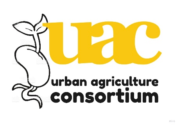By Rachel Hammond – Edge Landscaping. https://www.edgelandscaping.uk/
How it began: Todmorden to Oxford
The vision is that future housing, parks, public realm areas, rooftops, will all incorporate some form of productive planting, creating pockets of local food economy and therefore raising the value of food.
Rachel Hammond: Founder – Edge Landscaping.
As a young child rummaging around for new potatoes in the beautiful one-acre garden of my Grandparents who lived in Jersey, never did I imagine that so much of my future passion and work life would include food production.
Fast forward 20 years and I am now designing and installing edible and productive landscapes across the UK with various social, economic and environmental benefits.
I found myself based in Todmorden (West Yorkshire) just as Incredible Edible was starting out. In the five years I lived in Todmorden, I gardened, networked, and loved watching the success of the project across the town. All 3 of its plates were spinning successfully: Business, Community and Education, and the town was becoming a new place: one that operates around food.
This was an epiphany moment for me: food brings people together and creates jobs and a local economy.
To explain, the tourism and visitor attraction of Todmorden is in large part due to it being the first Incredible Edible, and has been running for the longest time, but a lot of what they have achieved can be replicated in towns and cities across the UK.
In 2012, following a move back to Oxford, I founded Incredible Edible Oxford by bringing together some likeminded people and gaining a small area to plant with herbs in one of the public parks.
Every time we worked on the plot, people stopped to talk to us, and it wasn’t long until we were asked to run sessions for various organisations and charities, such as this garden for Aspire:

Our herb patch in Florence Park became a Forest Garden, planted during a PDC in 2017:

Demand for edible gardens grows.
The more we worked on the garden and the more people saw it, we got requests to create private garden designs with edible or productive species, such as this medicinal forest garden which happens to be in Somerset:

Local Authorities and Schools also pulled us in to develop spaces for residents and pupils. Below, a Social Housing edible Project in Oxford during installation, carried out alongside the residents of the street; the children particularly enjoyed getting hands on.

The Forest Garden in the park became an invaluable teaching and demonstration space for our workshops and talking about Forest Gardens. It is designed in guilds, each with a different planting theme: teas, medicinal, salad, edible flowers, dye plants etc, which was aimed at being a teaching resource as well as a talking point for visitors to the park.

See a list of current courses run by Edge HERE
As well as residential and local authority design requests increasing, we started getting requests from Landscape Architects and designers to consult on larger designs, which we saw as a great way to implement more productive landscapes in the public realm.
To achieve more work beyond Oxford and not be confused with a volunteer led organisation (we were now able to pay a fair wage to everyone who delivered designs or teaching, at a flat rate), we changed our name to edge, edibles: design, grow, educate. I went to Oxford Brookes to do an Urban Design Masters, followed by a Landscape Architecture Masters, with the aim of working on larger projects such as town centres and housing estates.
The toolkit (click here)
Through the design degrees, it became apparent that future designers aren’t taught about incorporating food production, nor productive landscapes to any great extent, and my student peers looked at me very oddly when I explained what I had been doing for the previous 8 years As a result, I created this urban food production toolkit (below) as a response, and to encourage and support professionals to start incorporating productive planting in the landscape. 37 different food production systems elements and techniques are featured, based on a set of principles designed to encourage the incorporation of edible and productive systems in the public realm. Secondary schools are also using it in conjunction with outdoor learning.

The vision is that future housing, parks, public realm areas, rooftops, will all incorporate some form of productive planting, creating pockets of local food economy and therefore raising the value of food.
COVID-19 has shown the need for green spaces, and the fragility of our food system. I can only hope that through edge’s work, and the production of the toolkit, we can contribute positively to both elements.
Tips to other local food groups or aspiring food entrepreneurs:
- Find that one person [in an organisation such as a Council or School] who is also passionate about getting food growing on site and link up with them
- Talk to everyone you can about food growing in the public realm, network as much as possible – let people know what is possible
- Forest Garden style planting is the best for low maintenance, and cost saving is what a lot of organisations will be sold on
- Training is integral to the success of a project, to enable successional management of a project, and to bring in diversity of people and skills
- Establishing clear routes to market is essential for the distribution and sales of any produce – surplus or intended for sale, along with appropriate processing facilities where produce can be preserved, or value added to make it a saleable product
- Plant an example of productive planting to grab people’s attention and start the conversation

